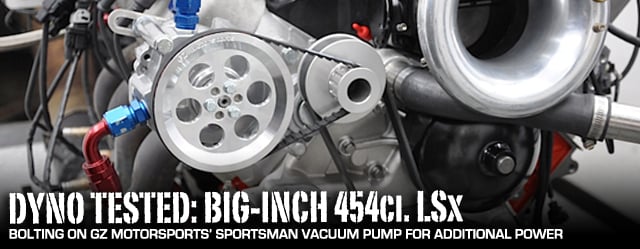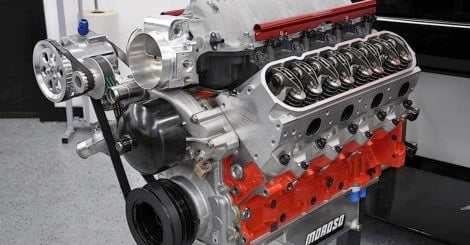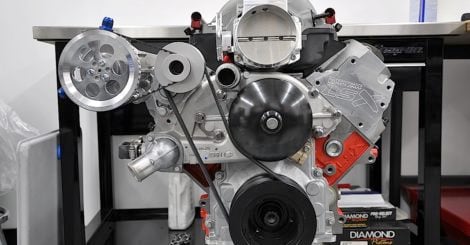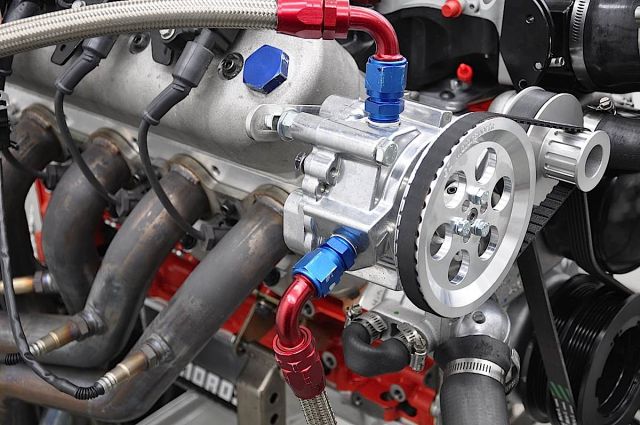I’m going to tell you something you don’t want to hear. Your engine has blow-by. Now, before you go crazy looking for plumes of billowing smoke from your valve cover breathers or planning your next tear down and rebuild, take comfort in knowing that every engine has blow-by to some degree.
Blow-by occurs when the exhaust gases created by combustion leak past the piston rings and make their way into the crankcase creating a positive pressure. Naturally aspirated engines feature some type of crankcase ventilation, whether by PCV valve (which circulates spent gases back into the intake charge) or just open breathers. Without a method in place to vent the crankcase, you’d find yourself wiping your garage floor of spilled oil quite frequently.
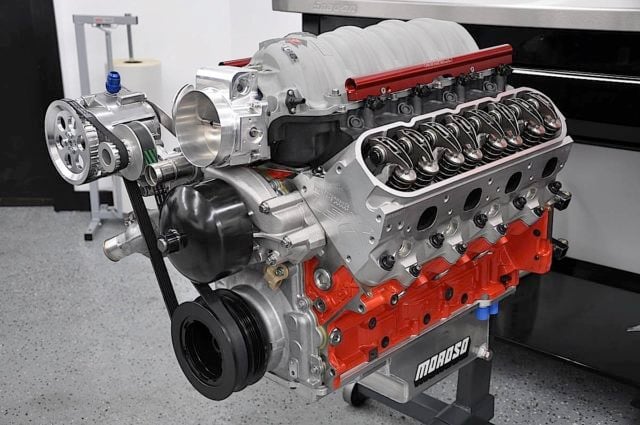
The GZ Motorsports vacuum pump rests at the front of the Late Model Engines (LME)-built 454 cubic-inch LSx test engine. Its small size keeps it unobtrusive and provides for a straightforward installation. The polished aluminum housing and –AN fittings add some functional pizzazz to any engine bay.
One way to decrease blow-by and increase piston ring seal is to add an aftermarket vacuum pump. Vacuum pumps work by creating negative airflow (vacuum) thereby pulling the air from the crankcase. They are rated by their airflow capacity measured in cubic-feet per minute (CFM) and are available in a variety of sizes. Which pump is right for you depends on your engine combination.
A smaller, naturally aspirated engine will effectively utilize a smaller pump than a larger displacement engine or one that employs power adders such as nitrous, superchargers, or turbo systems.
These engines produce higher crankcase pressures and, as such, necessitate a larger pump or greater RPM from a smaller model. A properly sized vacuum pump can net positive results in just about any engine. Your powerplant will enjoy increased ring seal, improved combustion, and less contamination of the intake charge. All of these benefits can improve your engines power output.
If you’re in the planning stages of your engine build, a vacuum pump allows for the use of looser, or low-tension, piston rings. This type of ring produces less friction on the cylinder walls and, as with any part of your performance machine, less friction equals more power. However, it’s important to note when using a standard tension ring package, typically, the horsepower increase won’t be as drastic. Horsepower is usually lower from the pump because of the increased leakage as compared to the low tension ring package.
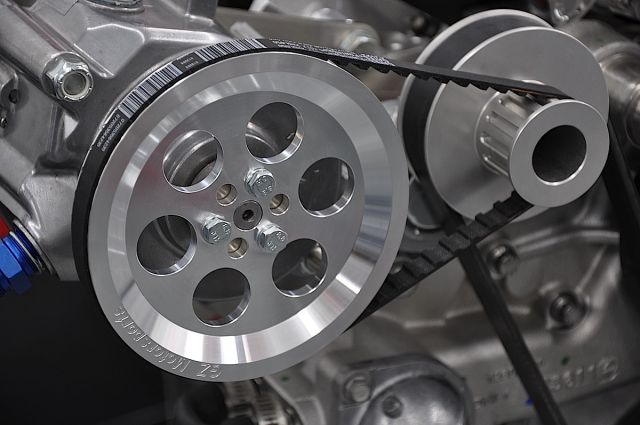
The T6 aluminum Gilmer vacuum pump pulley is included with both kits. It is available as a 36-tooth, 4.5-inch diameter piece or with 46 teeth and a 5.5-inch diameter. The smaller of the two will spin the pump faster and is better suited to lower RPM applications than its larger sibling. Spinning the pulley is the included 22.5-inch long Gilmer drive belt.
We wanted to put a vacuum pump to the test. So we contacted Greg Zucco – the “GZ” in GZ Motorsports, to checkout one his company’s LSx-specific Sportsman Series Vacuum Pump kits for a before-and-after dyno comparison. GZ Motorsports manufactures and sells a variety of vacuum pumps, available individually and in complete kits for a wide range of applications. We had the opportunity to phone into Zucco who immediately shared with us the increasing popularity of the pumps and the benefits of installing a vacuum pump on the LS series of engine. “Years ago, nobody knew much about vacuum pumps. I’ve seen an increase in familiarity of them especially on the LS engine side” Zucco is so sure of his pumps, he’s installed one on his personal vehicle and explained, “I personally run the Sportsman pump on my daily-driven, 2001 Z06 and noticed an immediate change in acceleration with no other modifications.” For GM’s venerable LS series of engines, they offer two options – the Super Pro kit and the Sportsman kit. Both kits are similar in contents, sans the larger pump and the hose and fitting size of the Super Pro version.
GZ Vacuum Pumps // Super Pro Kit & Sportsman Kit
The Super Pro Kit is suited for higher horsepower and power adder applications. It includes GZ’s VP104 33-cfm vacuum pump, and utilizes -12AN fittings and hose. The Sportsman Kit, which we used, features the smaller VP101A 22-cfm Sportsman pump, complete with -10 AN fittings and hose. Inside the pumps, both models share carbon fiber vanes and Rulon (a plastic material with a low coefficient of friction and high heat tolerance) wipers.
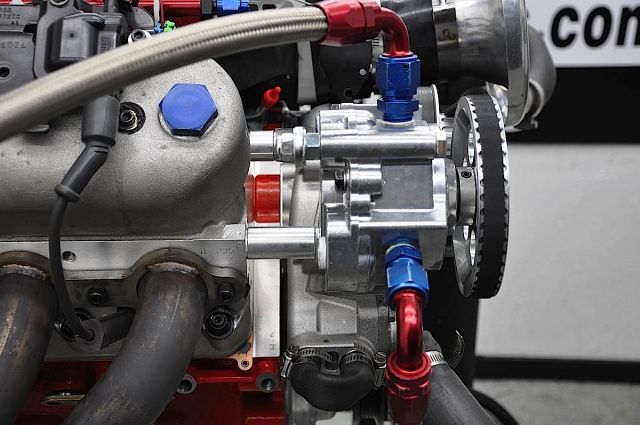
The GZ Motorsports kits come complete with Fragola AN fittings for one valve cover (-12AN for the Super Pro series and -10AN for the Sportsman line). Proper sealing of the valve covers is essential to the function of the vacuum pump.
The compact design of the Sportsman and Super Pro pumps will add a mere 6 and 6.5 pounds, respectively, to the front of your LS-based engine. Both feature a polished aluminum housing, so for those of you that like to show your ride, you’ll have something new to shine when you pop the hood. Also in the form-meets-function category is the Gilmer vacuum pump pulley that is included with both kits. Constructed of 6061 T6 aluminum and available with 36 or 46 teeth, the pulley diameter measures 4.5 or 5.5 inches, depending on the tooth count. As we mentioned, the smaller of the two will spin the pump faster and is better suited to lower RPM applications than its larger sibling.
Years ago, nobody knew much about vacuum pumps. I’ve seen an increase in familiarity of them especially on the LS engine side – Greg Zucco, GZ Motorsports
Essential to the proper function of the vacuum pump is the sealing of the valve covers. The GZ Motorsports kits come complete with Fragola AN fittings for one valve cover, -12AN for the Super Pro series and -10AN for the Sportsman line. Five feet of braided stainless steel hose is also included and is sized accordingly per kit.
GZ Motorsports provides their VCV103A adjustable vacuum-relief valve and oil-fill cap with each complete package. The valve and cap combination securely mounts and positively seals to the valve cover and allows for adjustments to the amount of vacuum.
It vents air directly to the pump without drawing it through the engine, unlike the aforementioned PCV valve system that pulls the combustion gases back into the intake stream. Easy adjustments can be made by simply turning a knob on the valve.
Video // GZ Vacuum Pump Design
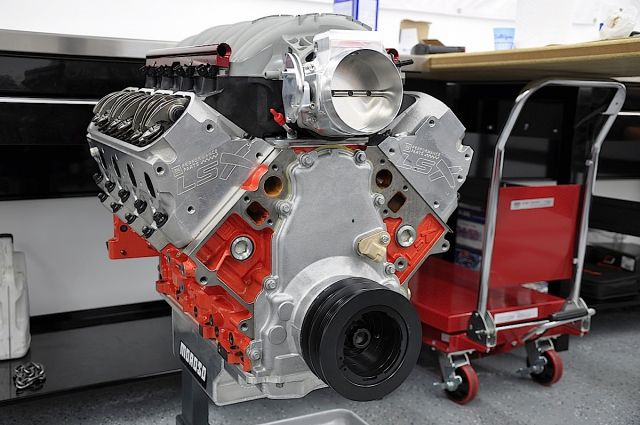
The LME-built 454 cubic-inch LSx engine, including a standard tension ring package awaits the finishing touches in anticipation of our before and after dyno testing. A stout performer, this engine combination produced gobs of power in a streetable powerband and on 93-octane pump fuel.
Both kits will net you an aluminum crankcase breather tank, complete with drain plug and open element breather. For you Corvette owners, GZ Motorsports saves you some headache by offering an option just for the confines of the C5 and C6 engine bays.
I personally run the Sportsman pump on my daily-driven, 2001 Z06 and noticed an immediate change in acceleration with no other modifications – Greg Zucco, GZ Motorsports
An aluminum manually adjustable tensioner pulley mount is available as an option with either kit. Zucco recommends this upgrade for applications that will see 7,000 RPM or greater.
With the popularity of the LS-series, GM’s latest small-block is making its way to the engine bays of muscle cars, classics, and alternative vehicle brands (read: Mustang hybrids, etc.). You might find one with an electric water pump, carburetor, or a V-belt in place of the serpentine system.
Not to worry, GZ Motorsports has the bases covered with a wide assortment of components that can be tailored to meet your specific needs. Customizable packages can be assembled so anyone with an LS-based combination can enjoy the benefits of an adjustable vacuum pump.
The GZ Motorsports Sportsman vacuum pump bolts together with simple hand tools. The gang at LME had the the new vacuum pump installed in no time. Before we knew it, it was time to get the LSx 454ci engine on the dyno for some testing.
GZ Motorsports // LSx Sportsman Complete Vacuum Pump Kit
The GZ Motorsports LSx Sportsman Vacuum Pump Kit is designed for the popular LS Series late-model Chevrolet engine and is specifically designed to fit perfectly in Chevy, Cadillac, GM Truck and Pontiac applications with a belt tensioner. For applications without a serpentine belt tensioner, like cars with an electric water pump, please make sure to get in contact with GZ Motorsports as custom setups are also available.
This Kit Includes the following items:
-
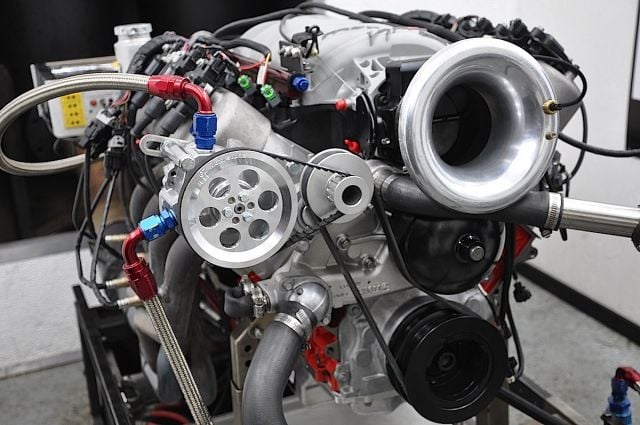
The GZ Motorsports Sportsman vacuum pump looks right at home on this high-tech small-block. It bolts on with no modifications to the factory GM accessories or brackets, making it suitable for installation by the home mechanic.
VP101A 22 cfm Sportsman Vacuum Pump - 36- or 46-tooth Gilmer vacuum pump pulley
- TP100 Custom Gilmer/serpentine pulley
- BT3 or BT2 (Corvette) breather tank
- 5ft. -10AN Stainless Braided Hose
- -10 Fragola AN fittings for one valve cover
- 22.5-inch long Gilmer belt
- VCV103A vacuum control valve oil fill cap
- Stud bolt, brace bracket, spacers and mounting bolts
- Optional T100 tensioner mount for high RPM applications
The Works // Late Model Engines-built LSx 454ci Dyno Mule
Armed with the GZ Motorsports Sportsman Vacuum Pump Kit, it was time to get to work testing the effects of increased vacuum. Bryan Neelen of Late Model Engines assembled the test mule 454 cubic inch LSx. A 4.185-inch bore and 4.125-inch stroke comprise the large displacement while an octet of Wiseco pistons top the connecting rods and help establish the 12:1 compression ratio.
Any properly-built engine can benefit from the addition of a vacuum pump, but the results will vary depending on the amount of blow by it generates and any air leaks that may be present. -Greg Zucco, GZ Motorsports
Topping the cylinders is a pair of LME CNC-ported GM LSx LS7 heads of the six-bolt-per-cylinder variety. A FAST intake manifold straddles the top of the assembly and hides the lobes of a Cam Motion hydraulic roller camshaft that opens the valves 0.650-inch for 247 and 262 degrees of crank rotation on the intake and exhaust, respectively. The lobe separation angle of the hydraulic roller cam is ground at a wide 114 degrees, effectively broadening the power band while bleeding off – or reducing – cylinder pressure.
This reduction in cylinder pressure allows the engine (and your wallet) to enjoy gulping 93 octane gas from the corner Pump N’ Go. With all these impressive features in a large-displacement package, how did it fare on the dyno?
The GZ Motorsports Sportsman Vacuum Pump kit quickly attaches with no modifications to the engine or engine accessories required for installation. With the vacuum pump installed and the big-inch terror ready to make another dyno pass, the proverbial trigger was pulled and the numbers recorded.
The Results // What’s It All Worth
With the negative airflow created by the vacuum pump pulling the positive pressure from the crankcase, the big-cuber screamed away to 712 horsepower at 6,900 RPM, an increase of 7 horsepower. Peak power RPM remained at 6,900. Peak torque fell by 1 ft-lbs. and didn’t reach it’s full potential until 200 RPM later at 5,600 to 577. On average, there was an increase of 6hp although average torque fell off by 2 ft-lbs.
Is a vacuum pump right for your combination? Greg says that for the maximum benefit to be realized, a looser piston ring package is optimum; however, the use of a vacuum pump doesn’t have to be factored into the initial build. Any properly-built engine can benefit from the addition of a vacuum pump, but the results will vary depending on the amount of blow-by it generates and any air leaks that may be present. The bottom line question one must ask is, “Do I really want to add more power to my engine combination?” If you read this far, the answer is obvious.
Summing It All Up // What Does It All Mean?
Is a vacuum pump right for your combination? While it had the appearance of a big ticket race item, Greg Zucco of GZ Motorsports says it is. For the maximum benefit to be realized, a looser piston ring package is optimum; however, the use of a vacuum pump doesn’t have to be factored into the initial build. Any properly-built engine can benefit from the addition of a vacuum pump, but the results will vary depending on the amount of blow by it generates and any air leaks that may be present.



